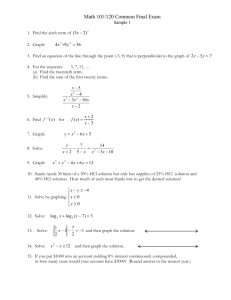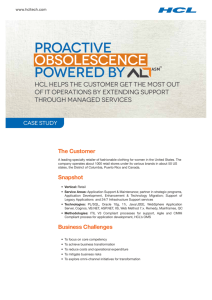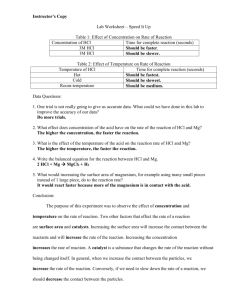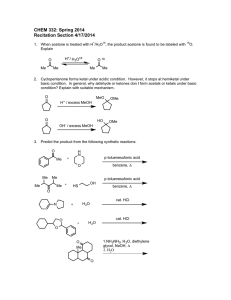Document 13310072
advertisement
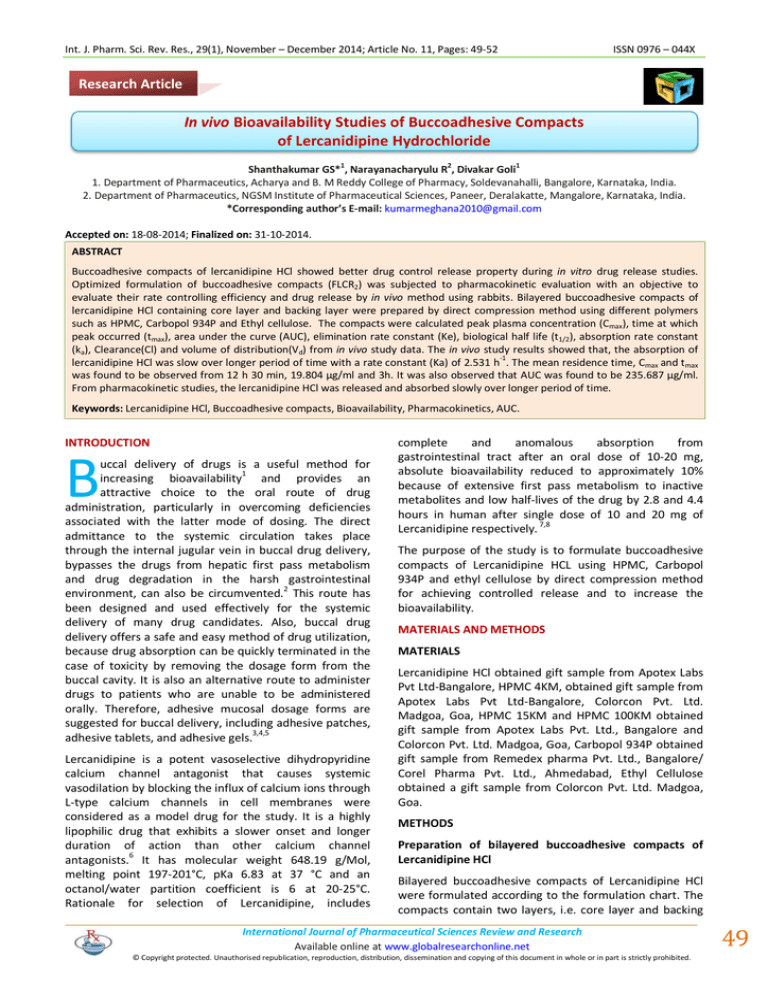
Int. J. Pharm. Sci. Rev. Res., 29(1), November – December 2014; Article No. 11, Pages: 49-52 ISSN 0976 – 044X Research Article In vivo Bioavailability Studies of Buccoadhesive Compacts of Lercanidipine Hydrochloride 1 2 1 Shanthakumar GS* , Narayanacharyulu R , Divakar Goli 1. Department of Pharmaceutics, Acharya and B. M Reddy College of Pharmacy, Soldevanahalli, Bangalore, Karnataka, India. 2. Department of Pharmaceutics, NGSM Institute of Pharmaceutical Sciences, Paneer, Deralakatte, Mangalore, Karnataka, India. *Corresponding author’s E-mail: kumarmeghana2010@gmail.com Accepted on: 18-08-2014; Finalized on: 31-10-2014. ABSTRACT Buccoadhesive compacts of lercanidipine HCl showed better drug control release property during in vitro drug release studies. Optimized formulation of buccoadhesive compacts (FLCR2) was subjected to pharmacokinetic evaluation with an objective to evaluate their rate controlling efficiency and drug release by in vivo method using rabbits. Bilayered buccoadhesive compacts of lercanidipine HCl containing core layer and backing layer were prepared by direct compression method using different polymers such as HPMC, Carbopol 934P and Ethyl cellulose. The compacts were calculated peak plasma concentration (Cmax), time at which peak occurred (tmax), area under the curve (AUC), elimination rate constant (Ke), biological half life (t1/2), absorption rate constant (ka), Clearance(Cl) and volume of distribution(Vd) from in vivo study data. The in vivo study results showed that, the absorption of -1 lercanidipine HCl was slow over longer period of time with a rate constant (Ka) of 2.531 h . The mean residence time, Cmax and tmax was found to be observed from 12 h 30 min, 19.804 µg/ml and 3h. It was also observed that AUC was found to be 235.687 µg/ml. From pharmacokinetic studies, the lercanidipine HCl was released and absorbed slowly over longer period of time. Keywords: Lercanidipine HCl, Buccoadhesive compacts, Bioavailability, Pharmacokinetics, AUC. INTRODUCTION B uccal delivery of drugs is a useful method for increasing bioavailability1 and provides an attractive choice to the oral route of drug administration, particularly in overcoming deficiencies associated with the latter mode of dosing. The direct admittance to the systemic circulation takes place through the internal jugular vein in buccal drug delivery, bypasses the drugs from hepatic first pass metabolism and drug degradation in the harsh gastrointestinal environment, can also be circumvented.2 This route has been designed and used effectively for the systemic delivery of many drug candidates. Also, buccal drug delivery offers a safe and easy method of drug utilization, because drug absorption can be quickly terminated in the case of toxicity by removing the dosage form from the buccal cavity. It is also an alternative route to administer drugs to patients who are unable to be administered orally. Therefore, adhesive mucosal dosage forms are suggested for buccal delivery, including adhesive patches, adhesive tablets, and adhesive gels.3,4,5 Lercanidipine is a potent vasoselective dihydropyridine calcium channel antagonist that causes systemic vasodilation by blocking the influx of calcium ions through L-type calcium channels in cell membranes were considered as a model drug for the study. It is a highly lipophilic drug that exhibits a slower onset and longer duration of action than other calcium channel 6 antagonists. It has molecular weight 648.19 g/Mol, melting point 197-201°C, pKa 6.83 at 37 °C and an octanol/water partition coefficient is 6 at 20-25°C. Rationale for selection of Lercanidipine, includes complete and anomalous absorption from gastrointestinal tract after an oral dose of 10-20 mg, absolute bioavailability reduced to approximately 10% because of extensive first pass metabolism to inactive metabolites and low half-lives of the drug by 2.8 and 4.4 hours in human after single dose of 10 and 20 mg of Lercanidipine respectively. 7,8 The purpose of the study is to formulate buccoadhesive compacts of Lercanidipine HCL using HPMC, Carbopol 934P and ethyl cellulose by direct compression method for achieving controlled release and to increase the bioavailability. MATERIALS AND METHODS MATERIALS Lercanidipine HCl obtained gift sample from Apotex Labs Pvt Ltd-Bangalore, HPMC 4KM, obtained gift sample from Apotex Labs Pvt Ltd-Bangalore, Colorcon Pvt. Ltd. Madgoa, Goa, HPMC 15KM and HPMC 100KM obtained gift sample from Apotex Labs Pvt. Ltd., Bangalore and Colorcon Pvt. Ltd. Madgoa, Goa, Carbopol 934P obtained gift sample from Remedex pharma Pvt. Ltd., Bangalore/ Corel Pharma Pvt. Ltd., Ahmedabad, Ethyl Cellulose obtained a gift sample from Colorcon Pvt. Ltd. Madgoa, Goa. METHODS Preparation of bilayered buccoadhesive compacts of Lercanidipine HCl Bilayered buccoadhesive compacts of Lercanidipine HCl were formulated according to the formulation chart. The compacts contain two layers, i.e. core layer and backing International Journal of Pharmaceutical Sciences Review and Research Available online at www.globalresearchonline.net © Copyright protected. Unauthorised republication, reproduction, distribution, dissemination and copying of this document in whole or in part is strictly prohibited. 49 Int. J. Pharm. Sci. Rev. Res., 29(1), November – December 2014; Article No. 11, Pages: 49-52 ISSN 0976 – 044X layer. Core layer was prepared by transferring a specified quantity of lactose, microcrystalline cellulose pH 102, mannitol, carbopol 934P and HPMC with different grades to the mortar and pestle and mixed well. Lercanidipine HCl was added to the above mixture and mixed well. Then specified quantity of magnesium stearate was added to the above mixture and mixed well. From the above core layer mixture specified quantity of powder was transferred to the 8mm die cavity of compression machine and compressed lightly. Then add a specified quantity of the backing layer powder containing ethyl cellulose, magnesium stearate and coloring agent to the 9,10 above core layer compact and compressed. Samples were withdrawn before administration of doses and after 1.0, 2.0, 3.0, 4.0, 8.0, 12.0, 24.0 h of dosing. The collected blood was harvested for 45 min at ambient temperature and centrifuged at 2000 rpm for 20 min. The clear supernatant serum layer was collected and stored at -40 °C until analysis. Frozen serum samples were thawed at ambient temperature (25±2 °C) for at least 60 min. A simple and efficient one-step process was employed to isolate Lercanidipine HCl from rabbit serum. To aliquot of 500 µl of serum samples, 1.5 ml of acetonitrile was added and vortexed for 1 min to ensure complete precipitation. Samples were vortexed again for 1 min and centrifuged at 10,000 rpm at 4 °C for 20 min. Preparation of calibration curve by HPLC The above protein-free plasma was mixed with 50µl Lercanidipine HCl acting as internal standard and 20µl was injected through syringe filter into an isocratic HPLC with UV detector. The column employed for the study was C18 (250 x 4.6mm, particle size: 5µm, High pressure gradient, Detector : UV Wavelength:240nm). The mobile phase consisted of potassium dihydrogen orthophosphate: ACN pH 4(40:60) and flow rate was adjusted to 1.0 ml/min. Accurately weighed 10mg of Lercanidipine HCl and transferred to 10ml volumetric flask and made up the volume up to 10 ml with methanol. From this solution 0.1ml was taken place in 10ml volumetric flask and the volume was made up to 10ml. The final concentration obtained is 10µg/ml. From this solution 2.5ml was taken place in 25ml volumetric flask and the volume was made up to 25ml. The final concentration obtained is 1000ng/ml. This was used as stock for calibration curve. A calibration curve was prepared by transferring 0.5, 1.0, 1.5, 2.0, 2.5ml aliquots into 10 ml volumetric flask and the volume was made up to the mark. Final concentrations obtained for Lercanidipine HCl were 50, 100, 150, 200, and 250 ng/ml in methanol to get the linearity. Pharmacokinetics study design and protocol The study was conducted with the approved in vivo study design and protocol (Protocol approval number: KSHEMA/AEC/28/2011 & IAEC/ABMRCP/2012-13/43) and as per guidelines prescribed by the Institutional Animal Ethics Committee. Six New Zealand White male rabbits with a mean weight of 2.5±0.24 kg were used for the study, (n=3). A washout period of 1 month with a crossover experimental design was followed for testing the formulation. Before starting the experimentation (810h) food was stopped to all animals. Food and water were not given to animals up to 2 h after the start of the study. To study the oral pharmacokinetics of Lercanidipine HCl, 1 ml of solution containing 0.388 mg of Lercanidipine HCl in 40% v/v polyethylene glycol 400 in water was administered to rabbits (n=3) using an oral catheter. The catheter was rinsed with 5 ml of 40% v/v polyethylene glycol 400 in water to ensure complete dosing. The formulated compact with 0.388 mg of Lercanidipine HCl was premoistened by dipping the compact in distilled water for 5 sec. The mouth of a rabbit (n=3) was opened using specially designed mouth restrainers and the pre-moistened compact was pressed gently against mucosal lining of the cheek using forceps for 1 min to ensure adhesion. Each rabbit was dosed with specific doses of Lercanidipine HCl (0.388 mg) without taking the weight of the rabbit into consideration. The blood samples (1 ml) were withdrawn from the marginal ear vein of rabbits using a 21 G needle for each study. From the time v/s serum drug concentration data various pharmacokinetic parameters such as peak plasma concentration (Cmax), the time at which peak occurred (tmax), area under the curve (AUC), elimination rate constant (Ke), biological half life (t1/2), absorption rate constant (ka), Clearance(Cl) and volume of distribution(Vd) were calculated as per known calculation methods. Highest concentration of drug in plasma attained by the administrated dose is Cmax. Time taken to reach maximum concentration of drug in plasma is tmax. Area under the curve was calculated by using trapezoidal rule and formula is given by = (Y − Y )(X + X ) 2 ‘VD’ was calculated by using the following formula V = Administered dose Initial plasma concentration Biological half life(t1/2) was calculated by using the following equation t / = 0.693 K Ke = Elimination rate constant Absorption rate constant was calculated by using the method of residuals. Clearance (Cl) was calculated by using the following equation Cl = . Mean residence time was calculated based on 63.2% of drug eliminated from the body. 11,12,13 International Journal of Pharmaceutical Sciences Review and Research Available online at www.globalresearchonline.net © Copyright protected. Unauthorised republication, reproduction, distribution, dissemination and copying of this document in whole or in part is strictly prohibited. 50 Int. J. Pharm. Sci. Rev. Res., 29(1), November – December 2014; Article No. 11, Pages: 49-52 ISSN 0976 – 044X RESULTS AND DISCUSSION From HPLC method, standard calibration data and linearity of Lercanidipine HCl was shown in Table 1 & Figure 1. Standard chromatogram of the Lercanidipine pure drug was shown in Figure 2. Highest sharp peak at 4.315 in the chromatogram was observed. Table 1: Standard calibration data of Lercanidipine HCl by HPLC Concentration (ng/ml) Peak Area (Mean ± SD) 0 0 50 816.781 100 1660.016 150 2672.583 200 3602.1 250 4565.55 Figure 3: Determination of lercanidipine HCL in rabbit Plasma by HPLC Area under the curve Plasma drug concentration (µg) 25 Linearity 5000 y = 17.96x R² = 0.997 4000 Peak area 3000 2000 19.804 20 15.39 15 13.282 4.468 5 0 0 0 0 100 200 Concentration (ng) 9.206 10 0 1000 13.473 13.268 5 10 20 25 Time(h) 300 Figure 1: Standard Linearity Curve by HPLC 15 Figure 4: Time v/s Plasma drug concentration area under the curve of Lercanidipine compacts (FLCR2) From Area under the curve, the extent of drug absorption after 24 h was calculated. Cmax was found to be 19.804 µg/ml, tmax was found to be 3 h. The elimination rate constant Ke for lercanidipine was found to be 0.91 h and the corresponding half life was found to be 0.76 h. The mean residence time was found to be 12 h 30 min. The absorption rate constant Ka was found to be 2.531 h-1. The results were shown in Table 2 and Figure 4. Parameters for HPLC method development was given below Figure 2: Standard chromatogram for Lercanidipine HCl by HPLC Lercanidipine HCl drug peak at 4.698 was observed in rabbit plasma as shown in Figure 3. Plasma drug concentration of Lercanidipine HCl compacts (FLCR2) following the oral administration to Rabbits was shown in Figure 4. Time v/s Average plasma drug concentration profiles of Lercanidipine HCl compacts AUC were plotted as shown in Figure 4. From AUC pharmacokinetic parameters was calculated as shown in Table 2. Mobile phase: Potassium dihydrogen orthophosphate (0.01M):ACN pH 4(40:60) Detector : UV detector, nm: 240 Flow rate: 1ml/minute Injection volume; 20µl Diluent: Acetonitrile Column dimension: 250x4.6 mm, 5µ International Journal of Pharmaceutical Sciences Review and Research Available online at www.globalresearchonline.net © Copyright protected. Unauthorised republication, reproduction, distribution, dissemination and copying of this document in whole or in part is strictly prohibited. 51 Int. J. Pharm. Sci. Rev. Res., 29(1), November – December 2014; Article No. 11, Pages: 49-52 Table 2: Pharmacokinetic parameters Pharmacokinetic Parameters Observation Cmax 19.804 µg/ml tmax 3h AUC (0-24) 235.687 µg.h/ml Elimination rate constant (Ke) 0.91 h Biological half life 0.76 h Vd 0.029 L Absorption rate constant(Ka) 2.531 h Mean residence time (MRT) 12 h 30 min Clearance (Cl) 0.0016 ISSN 0976 – 044X REFERENCES 1. Ikinci G, Senel S, Wilson CG, Sumnu M, Development of a buccal bioadhesive nicotine tablet formulation for smoking cessation, Int J Pharm., 277, 2004, 173-178. 2. Yajaman Sudhakar, Ketousetuo kuotsu, Bandyopadhyay AK, Buccal bioadhesive drug delivery-A promising option for orally less efficient drugs, J Controlled Release, 114, 2006, 15-40. 3. Anders R, Merkle HP, Evaluation of laminated mucoadhesive patches for buccal drug delivery, Int J Pharm., 49, 1989, 231-240. 4. Dortunc B, Ozer L, Uyanik N, Development and in vitro evaluation of a buccoadhesive pindolol tablet formulation, Drug Dev Ind Pharm., 24,1998, 281-288. 5. Ishida M, Nambu N, Nagai T, Highly viscous gel ointment containing Carbopol for application to the oral mucosa, Chem Pharm Bull (Tokyo)., 31, 1983, 4561-4564. 6. Bang LM, Chapman TM, Goa KL, Lercanidipine a review of its efficacy in the management of hypertension, Drugs, 63, 2003, 449-2472. 7. Barchielli M, Dolfini E, Farina P, Leoni B, Targa G, Vinaccia V et al., Clinical pharmacokinetics of lercanidipine, J Card Pharmacology ., 29,1997, S1-S15. 8. Available from: https://data.epo.org/publicationserver/ getpdf.jsp?pn=1600441&ki=A2&cc=EP. Accessed on 24-102011. 9. Vishnu M. Patel, Bhupendra G. Prajapati, Madhabhai M. Patel, Formulation, evaluation and comparison of bilayered and multilayered mucoadhesivebuccal devices of propronalol hydrochloride, AAPS PharmSciTech, 8(1), 2009, E1-E8. -1 CONCLUSION Lercanidipine HCl compacts were released the drug prolonged period of time. The mean residence time was found to be 12 h 30 min, indicates that more residence time was observed. From the pharmacokinetic evaluation, it was concluded that Lercanidipine HCl compacts was released and absorbed slowly over a prolonged period of time. It was also concluded that the designed buccoadhesive compacts can overcome the disadvantage of poor and erratic oral bioavailability of LER associated with currently marketed formulations. Acknowledgement: Authors very thankful to Apotex Labs Pvt Ltd-Bangalore, Colorcon Pvt. Ltd, Verna, Goa, Corel Pharma Pvt. Ltd., Ahmedabad, Remedex Pharma Pvt. Ltd., Bangalore, for providing the gift samples. Authors thankful to Dr. R.Narayanacharyulu, Vice-Principal, N.G.S.M. Institute of Pharmaceutical Sciences, Mangalore, Karnataka, India, for his continuous encouragement, valuable suggestions, dynamic guidance, ever readiness to solve my problems, moral support and blessings shown to me throughout the period of this work. Authors also thankful to chairman, Principal, and staff, Acharya & B.M. Reddy College of Pharmacy, Bangalore for their support and providing the facilities for my project work.. 10. Ganesh P, Balamurugan M, Saravanan VS, Senthil SP, Hemalatha PV, Sudhir Pandya, Development and in vitro evaluation of mucoadhesive buccal tablets of domperidone, Res. J. Pharm. Tech, 1(4), 2008, 377-380. 11. Madhan PL, Biopharmaceutics and Pharmacokinetics. New Delhi: Jaypee brothers, 2000, 232-280. 12. Shrikant Charde, Madri Mudgal, Lajwinder Kumar, Ranendra Saha, Development and Evaluation of Buccoadhesive Controlled Release Tablets of Lercanidipine, AAPS Pharm Sci Tech., 9(1), 2008, 182-190. 13. Chowdary KPR, Prithwiraj M, Murali Krishna MN, Pharmacokinetic evaluation of Natural resins coated microcapsules of Nifidifine, Asian J of Chem, 21(6), 2009, 4199-4204. Source of Support: Nil, Conflict of Interest: None. International Journal of Pharmaceutical Sciences Review and Research Available online at www.globalresearchonline.net © Copyright protected. Unauthorised republication, reproduction, distribution, dissemination and copying of this document in whole or in part is strictly prohibited. 52
